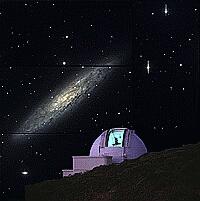- The Oxford Deep WFC Survey. PI: Dalton (Oxford).
- Multi-Coloured Large Area Survey of the Virgo Cluster. PI: Davies (Cardiff).
- The Faint Sky Variability Survey II. PI: van den Heuvel (Amsterdam).
- The INT Wide Angle Survey. PI: McMahon (Cambridge).
- The Local Group Census. PI: Walton (ING, La Palma).
- An Imaging Programme for the XMM-Newton Serendipitous X-ray Sky Surveys. PI: Watson (Leicester).
| THE ING NEWSLETTER | No. 4, March 2001 |
|
|
THE ING WIDE FIELD IMAGING SURVEY | SCIENCE |
|
|
|
| Previous: | Pipeline Data Processing | Up: | Table of Contents | Next: | High Redshift Quasars in the ING Wide Field Survey |
Other available formats: PDF | gzipped Postscript
|
The
Second Round of Wide Field Survey Observations
René Rutten (ING) |

THE ING WIDE FIELD IMAGING SURVEY |
The assessment of the proposals this time was left largely in the hands of the UK and NL time allocation panels, who were for the occasion strengthened with two independent assessors. This, it was hoped, would answer the criticism heard in the community during the previous round in 1998. Progress on these proposals will be reviewed annually, based upon which further allocations will be granted.
As for the previous round, the data will be accessible to the wider astronomical community in the UK and the NL though the ING archive based in Cambridge. There will be no propietary period in order to promote fast and wide exploitation of the survey data.
From the proposals
received, the following six were selected and will be granted observing
time:
A brief description
of each proposal follows:
The Oxford Deep WFC Survey also is a continuation of a previous survey proposal. Its principal scientific aim is to study weak lensing by large-scale structure, the angular clustering of faint galaxies, the clustering of Lyman-break galaxies at high redshift and to measure the luminosity function of faint and distant QSOs.
The project Multi-Coloured
Large Area Survey of the Virgo Cluster will complete the survey that
has already been carried out in the B-band with U, Z and H-alpha images
of this galaxy-rich region of the nearby Universe. This will allow determination
of the luminosity function as a function of colour and position in the
cluster down to luminosities equivalent to the local dwarf spheroidals.
The Faint Sky Variability Survey II. is an extension of a programme
that was also granted time in previous round. Its aim is to survey 40 square
degrees of sky for photometrically and astrometrically variable objects
down to 25th mag. The variability domain will be gauged on timescales between
tens of minutes to years. Prime targets of this survey are cataclysmic
variables and AM CVn stars, RR Lyrae stars, GRBs, high proper motion stars
and Kuiper Belt objects.
The INT Wide Angle Survey, is also a continuation of an existing survey programme and is the first digital survey over a significant section of the sky (~100 square degree) going significantly deeper than previous sky surveys. Although focussed on three specific observational goals, it will provide a multi-colour general-purpose sky survey that will serve many future studies on 8-m class telescopes.
The Local Group Census project will provide a deep narrow band imaging resource of all Local Group galaxies in the Northern Hemisphere. This will enable both old and new emission line populations (e.g. planetary nebulae and luminous blue variables) to be catalogued. Analysis of the population samples across a wide range of galaxy types in the Local Group will shed light on evolutionary processes. This survey would provide an important resource for spectroscopic follow-up studies with larger telescopes.
Finally, the Imaging
Programme for the XMM-Newton Serendipitous X-ray Sky Surveys will obtain
images of some 200 fields drawn from the XMM-Newton observing programme.
This will provide an X-ray/optical catalogue of 10,000 to 20,000 sources
over 25 square degrees of the sky, which would serve a wide range of astrophysical
problems, such as the obscuration of faint AGN population, the evolution
of quasar luminosity with redshift, coronal activity on stars, and space
density of accreting binary systems.
Email contact: René Rutten (rgmr@ing.iac.es)
| Previous: | Pipeline Data Processing | Up: | Table of Contents | Next: | High Redshift Quasars in the ING Wide Field Survey |
| GENERAL | THE ING WIDE FIELD IMAGING SURVEY | SCIENCE | TELESCOPES AND INSTRUMENTATION | OTHER NEWS FROM ING | TELESCOPE TIME |